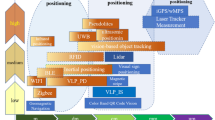Abstract
Traditional visible light-based positioning technology of deploying the receiver under the transmitter (i.e., LEDs deployed on the top and photodetectors deployed on the ground) in the mine tunnel is unreliable for optical signal reception and difficult to implement due to the complex mine tunnel environment such as occlusion of objects (e.g., Ore and Minecarts) on the ground. To address this issue, we propose a reliable visible light-based underground positioning algorithm that uses a novel reverse transceiver position mechanism, i.e., utilizing the existing miner’s headlamp as the transmitter below and the photodiodes deployed on the top of the mine tunnel as the receiver above for broadcasting and receiving the light beacon representing miner’s identity information. We determine the current location of each person through a series of base stations constructed by the receiver and achieve real-time positioning of all people combined with inertial navigation. We also overcome some technical challenges for this mechanism and the mine environment, including optimal frequency selection, robust frequency identification, and accurate base station positioning. The experiments show that the average positioning error of the base station is 0.06 m and the real-time location accuracy is 98% error of 2.5 m or less.
This work was supported by the National Natural Science Foundation of China under Grant 51774282 and Grant 51904294.
Access this chapter
Tax calculation will be finalised at checkout
Purchases are for personal use only
Similar content being viewed by others
References
Farjow, W., Raahemifar, K., Fernando, X.: Novel wireless channels characterization model for underground mines. Appl. Math. Model. 39(19), 5997–6007 (2015)
Huang, C., Zhang, X.: Impact and feasibility of darklight led on indoor visible light positioning system. In: 2017 IEEE 17th International Conference on Ubiquitous Wireless Broadband (ICUWB), pp. 1–5. IEEE (2017)
Singh, S., Kakamanshadi, G., Gupta, S.: Visible light communication-an emerging wireless communication technology. In: 2015 2nd International Conference on Recent Advances in Engineering & Computational Sciences (RAECS), pp. 1–3. IEEE (2015)
Zhou, X., Campbell, A.T.: Visible light networking and sensing. In: Proceedings of the 1st ACM Workshop on Hot Topics in Wireless, pp. 55–60 (2014)
Lee, K., Park, H.: Modulations for visible light communications with dimming control. IEEE Photonics Technol. Lett. 23(16), 1136–1138 (2011)
Kuo, Y.S., Pannuto, P., Hsiao, K.J., Dutta, P.: Luxapose: indoor positioning with mobile phones and visible light. In: Proceedings of the 20th Annual International Conference on Mobile Computing and Networking, pp. 447–458 (2014)
Jerri, A.J.: The Shannon sampling theorem–its various extensions and applications: A tutorial review. Proc. IEEE 65(11), 1565–1596 (1977)
Yang, F., Li, S., Yang, Z., Qian, C., Gu, T.: Spatial multiplexing for non-line-of-sight light-to-camera communications. IEEE Trans. Mob. Comput. 18(11), 2660–2671 (2018)
Li, T., An, C., Tian, Z., Campbell, A.T., Zhou, X.: Human sensing using visible light communication. In: Proceedings of the 21st Annual International Conference on Mobile Computing and Networking, pp. 331–344 (2015)
Murdoch, J.B.: Inverse square law approximation of illuminance. J. Illum. Eng. Soc. 10(2), 96–106 (1981)
Li, T., Xiong, X., Xie, Y., Hito, G., Yang, X.D., Zhou, X.: Reconstructing hand poses using visible light. Proc. ACM Interact. Mob. Wearable Ubiquit. Technol. 1(3), 1–20 (2017)
Niu, Q., Yang, X., Yin, Y.: IPL: image-assisted person localization for underground coal mines. Sensors 18(11), 3679 (2018)
Author information
Authors and Affiliations
Corresponding author
Editor information
Editors and Affiliations
Rights and permissions
Copyright information
© 2020 Springer Nature Switzerland AG
About this paper
Cite this paper
Pang, M., Zhang, K., Yang, X., Yin, Y., Gao, S., Chen, P. (2020). Reliable Visible Light-Based Underground Localization Utilizing a New Mechanism: Reverse Transceiver Position. In: Yu, D., Dressler, F., Yu, J. (eds) Wireless Algorithms, Systems, and Applications. WASA 2020. Lecture Notes in Computer Science(), vol 12385. Springer, Cham. https://doi.org/10.1007/978-3-030-59019-2_7
Download citation
DOI: https://doi.org/10.1007/978-3-030-59019-2_7
Published:
Publisher Name: Springer, Cham
Print ISBN: 978-3-030-59018-5
Online ISBN: 978-3-030-59019-2
eBook Packages: Computer ScienceComputer Science (R0)




